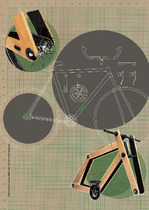| dc.contributor.author | Arbeláez Ochoa, Elsie María | |
| dc.coverage.spatial | Seccional Medellín | spa |
| dc.date.accessioned | 2021-01-21T13:32:14Z | |
| dc.date.available | 2021-01-21T13:32:14Z | |
| dc.date.issued | 2015 | |
| dc.identifier.uri | http://hdl.handle.net/20.500.11912/7484 | |
| dc.description | p. 74 - 80 | spa |
| dc.description.abstract | El siguiente artículo tiene un carácter reflexivo para el diseño. Su propósito es plantear la hermenéutica como ejercicio para entender e interpretar su episteme a través de su trayecto histórico. Se distingue aquí un vínculo específico entre el flujo lingüístico y la experiencia de mundo al que nos abre el diseño, algo que lleva a preocuparse por su esencia ontológica. Proponemos pensar un diseño con sentido social, responsable y ético, en función de su razón de ser, que da cuenta de su esencia, el onto-proyectista. Se tiene en cuenta para este diálogo hermenéutico lo político, lo social, lo cultural y lo estético, como ejes para interpretar el sentido que tiene la ética en la disciplina del diseño. La reflexión ontológica, aquí expresada para el diseño, adquiere importancia solo desde el lenguaje hermenéutico, que muestra las representaciones que se articulan en la práctica del diseño. La manera dialogal sugerida sitúa la lectura y la reflexión sobre los elementos conceptuales en la episteme del diseño. | spa |
| dc.description.abstract | The following article has a reflective character for design. Its purpose is to suggest hermeneutics as an exercise to understand and interpret its episteme through its historic journey. Differentiated here is a specific link between linguistic flow and on experience of the world we are given by design, which leads to worrying about their ontological essence. We propose thinking of a design with social, responsible and ethical sense, depending on its raison d’être, which realizes its essence, the onto-designer. It is taken into account for this hermeneutical dialogue political, social, cultural and aesthetic domains as axes to interpret the meaning that ethics has in the discipline of design. The ontological reflection, here expressed for design, becomes important only from the hermeneutical language, showing the representations that are articulated in design practice. The suggested dialogic way places reading and reflection on the conceptual elements in design episteme. | spa |
| dc.format.mimetype | application/pdf | |
| dc.language.iso | spa | |
| dc.publisher | Universidad Pontificia Bolivariana | spa |
| dc.relation.ispartof | Iconofacto | spa |
| dc.rights | Attribution-NonCommercial-NoDerivatives 4.0 International | * |
| dc.rights.uri | http://creativecommons.org/licenses/by-nc-nd/4.0/ | * |
| dc.subject | Hermenéutica del diseño | spa |
| dc.subject | Episteme del diseño | spa |
| dc.subject | Ética y onto-proyectista | spa |
| dc.subject | Hermeneutics design | spa |
| dc.subject | Design episteme | spa |
| dc.subject | Ethics and onto-designer | spa |
| dc.title | El diseño como disciplina eminentemente práctica, transformativa y comunicativa | spa |
| dc.title.alternative | Design as an eminently practical, transformative and communicative discipline | spa |
| dc.type | article | spa |
| dc.rights.accessRights | openAccess | spa |
| dc.type.hasVersion | publishedVersion | spa |
| dc.description.sectional | Medellín | spa |
| dc.identifier.instname | instname:Universidad Pontificia Bolivariana | spa |
| dc.identifier.reponame | reponame:Repositorio Institucional de la Universidad Pontificia Bolivariana | spa |
| dc.identifier.repourl | repourl:https://repository.unab.edu.co/ | |


